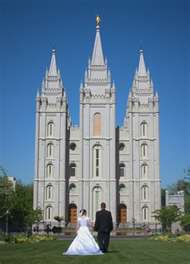
Of the many similarities and differences between Jewish and Mormon culture and tradition, the tradition of marriage in each culture, between a man and a woman, bears explanation, contrast and comparison. In another post I will explore the problems related to intermarriage between a Jew and a non-Jew, a practice that is increasingly common in our day.
In traditional Jewish literature marriage is called kiddushin (betrothal) and is followed by the second step, nisuin (full-fledged marriage). Kiddushin occurs when the wife-to-be accepts the terms of the prospective husband. It has a sanctifying effect upon this union and it serves a particular purpose. Anciently the normal time period between betrothal and marriage was one year, but today both ceremonies are performed together. I am an Ashkenazic Jew (Germany, Slavic territories, Russia, Western and Central Europe) and not familiar with differences in the marriage rites of the Sephardic Jews (the Iberian peninsula: Turkey, the Middle East, Spain, Portugal).
When we explore Torah (five books of Moses) we find little guidance to the procedures of marriage, but Talmudic study (oral interpretation of Torah) gives us many answers. A rabbi has written that matches between man and woman are made in heaven prior to a male child’s conception. It is a Jewish idea that first and even second marriages are foreordained, controlled by “bashert”, a Yiddish word meaning fate or destiny. Bashert denotes a fortunate and happy match. The term can apply to many things in life but finding one’s soul mate is what Jews hope and search for. In this sense, marriage takes on a mystical quality, if not a spiritual one. Prayers to God for successful marriages are offered by all who are involved with Jewish courtship and marriage.
<According to rabbinic law, then, a proper marriage must be sanctified. It is not only a social and intimate arrangement, but a spiritual one between a man, a woman and God. That union is the fulfillment of a mitzvah – a commandment from God that each partner will be faithful in living a dedicated and happy life with the spouse. A rabbi is not required to perform the ceremony but usually they officiate because required by U.S. civil law. (See www.jewfaq101.com for in depth commentary)
Jews are taught that love and companionship MUST come before childbearing. Dedication, energy and much effort and planning are central to these exclusive relationships of the heart. Sometimes the marriage partners decide they cannot uphold their vows. Judaism allows divorce, but with caveats. A man can marry a second wife, but according to ancient Torah and Talmud dictated law, if a woman becomes divorced, she must not marry again. The possibilities of fate are carefully legislated by the making of a contract, or ketubah, to spell out terms of the marriage and/or divorce. The Hebrew word ketubah means “writing”. It spells out the husband’s basic obligations to his wife during marriage, conditions of the inheritance upon his death, as well as his obligations toward the support of their children during marriage. The husband cannot force his wife to his will or abuse her in any way, including sexually. Other local and legal factors may be added to the ketubah contract. These contracts are intended to influence constancy in marriage and discourage divorce.

A note here that these rules of behavior are adhered to in modern times by Orthodox and, to a lesser degree, Conservative congregations. Reform and other more liberal congregation members often follow their own plans and may circumvent Jewish ways entirely.
The wedding ceremony usually follows Jewish tradition, but with so much intermarriage in modern times, many other factors can interrupt or change this centuries-old way of planning marriages. Customarily, the bride and groom do not see each other one week prior to marriage. On the Shabbat (Friday eve following sunset or moonrise) the groom, if he is an Ashkenazic Jew, performs an aliyah (blessing )over a Torah reading. A fast is begun the day prior to the wedding. The bride is veiled prior to the ceremony, a symbolic re-enactment of the story of Rebecca , who was veiled when she was first brought to Isaac to be his wife.
The couple observe numerous Hebraic symbolic rites repeated from centuries past, including the recitation of seven blessings in the presence of a quorum or minyan of ten adult Jewish men, Numerous symbolic rites are performed before the marriage is completed and finally the couple drink wine after the prayer and the groom smashes the glass cup with his right foot to symbolize the destruction of the Temple of Herod. Jewish marriages are for life. In the world to come there is no certainty that families can be together, for there are no passages in the Hebrew Bible or Old Testament guaranteeing such things, and the Talmud writers are more wishful than certain because they have no other information. The Jewish people live for this world. They are a strongly family oriented people and proud of their heritage, their unique ways of life and they hold to their traditions with great tenacity!
With all the buzz over getting married, the lack of finding one’s beshet has unhappy consequences. When a Jewish man does not marry, it is considered unnatural and unholy because it is assumed he always thinks of sinning. He is not invited into the social life of those who are united in a holy union. He cannot, of course, have more than one wife at a time, although we find it practiced commonly through the Old Testament. Ashkenazic Jewry eventually banned the practice of polygyny (form of marriage in which a man has two-4 wives simultaneously) due to pressure from Christian culture, though it is still legal among Ethiopian and Sephardic (those from Iberian peninsula: Turkish, Spanish) Jews . Note: Polygamy is a different type of relationship. It means a spouse of either sex may have more than one mate at the same time. Neither Jews nor members of the authorized LDS church practice polygamy.
Remember that Jewish courtship and marriage practices are purposely rooted in ancient tradition, to keep the flavor and remembrance of what it is to be a Jew.
*************** ***************
Mormon marriages follow some of the same traditions and patterns as Jewish unions. It is a social and spiritual union, exclusive and intimate. Partners in romantic relationships that might or will lead to marriage invoke prayer to determine the will of the Lord. Many LDS courtships are shorter than one year if it is determined that each partner is meant to be an eternal companion.
In Western nations it is expected that youth will not begin dating until age 16 but serious relationships are discouraged at such a young age. Males are urged to serve a 2-year mission at age 19 with thoughts and actions devoted to the work at hand, before courting and marrying. Since missionaries have companions throughout their service, they get first hand training in cooperation, trust and interdependence with their assigned partner. Both partners are strongly encouraged to remain chaste. Premarital sex is considered sinful – see 1 Cor 6:18. This type of relationship is hoped to become finalized in one of the LDS temples where couples make binding commitments to each other for time and eternity. There are no separate ceremonies for betrothal and marriage.
Years ago, I remember a prophet of the church cautioning anyone dating to refrain even from kissing on the lips until the marriage ceremony was certain, so the whole emphasis is put upon love, companionship, mutual commitment to one another and to a spirit-fed lifetime together. It is unlikely this stringent advice is followed in our day, but chastity is expected of Mormons in all relationships (David O. McKay, Gospel Ideals, 1953, p. 458). Wholesome group activities are always encouraged during courtship. It reduces regrets later on!
Mormons are encouraged to marry in LDS temples because there they take upon themselves authorized, binding and eternal covenants. Mormons believe these covenants, if kept, are a major stepping stone to eternal life with Heavenly Father and Jesus Christ and worthy family members after death. For a marriage to be eternal it must meet four conditions which are: 1) it must be made and entered into and sealed by the Holy Spirit of promise. 2) It must be performed by “him who is anointed”–in other words who is properly authorized to perform the eternal marriage. 3) It must be done “both as well for time and for all eternity.” And 4) it must be done by revelation and commandment through the medium of mine anointed.” (See Doctrine and Covenants 132:4-28) The principle that supports eternal marriage come from the power that Jesus gave to Peter to seal (bind forever) in heaven that which is bound on the earth. (Matt 19:4-6)
When children are born to the marriage, they can be bound to their parents for eternity in an LDS temple. The whole emphasis is put upon raising eternal families in joy and fellowship. LDS teachings are based upon the revelations given to the Prophet Joseph Smith and successive prophets of the church that assure us of eternal life with our God if we hearken to Him and obey his commandments so we can live free of sin and sorrow and find joy in this life. Everything is taught with the idea of the bestowal of eternal blessings through repentance, faith, baptism by one having authority (the restored Aaronic and Melchizedek priesthoods), and the laying on of hands for the gift of the Holy Ghost.
Sometimes marriages fail or a partner dies. The remaining spouse may marry again in the temple if certain conditions are met by both partners. Marriage in a civil ceremony can precede a temple marriage. Because the Bible is incomplete in its teachings of eternal marriage, the teachings found in the Doctrine and Covenants provide clarification and instructions as to the Lord’s wishes. In that sacred work, the author identifies himself as the Savior of the world and author of that work.
I believe it important for my readers to understand this posting and hope they will share it with their friends, Jewish and Mormon. Questions? Email me at: [email protected]. Until next time,
Marlena Tanya Muchnick
www.jewishconvert-lds.com
www.peopleofthebook-judaica.com
http://comeuntochrist.blogspot.com
http://judaicaworld.blogspot.com
http://judaicaworld.wordpresss.com



